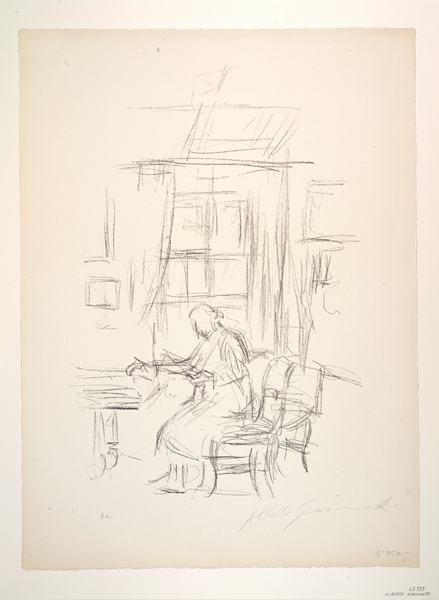
Alberto Giacometti
Mère de l’Artiste à la Fenêtre
Stampa, Switzerland, 1901 – Chur, Switzerland, 1966
In 1922, Giacometti went to study in Paris and was admitted to the Académie de la Grande Chaumière, where he took lessons from the sculptor Antoine Bourdelle. It was then that he learnt the technique of drawing from a model and became interested in avant-gardist compositions, especially those by the Post-Cubists. In 1929, he began a series of flat female figures, whose novelty got him noticed by the Surrealist artistic milieu. In 1931, Giacometti joined André Breton’s Surrealist movement. Surrealist subjects have an important place in his oeuvre: love and death, dreamlike visions, objects with a symbolic function. Meanwhile, he created a number of utilitarian objects, such as lamps, vases and wall lights, for the avant-garde decorator Jean-Michel Frank. From 1935, he broke away from the Surrealist group to focus intensely on the question of the human head, which remained a central element in his research throughout his life. After spending the war years in Switzerland, he returned to Paris, and addressed himself once again to investigating the human figure. His preferred models were those who lived alongside him: Annette, his wife from 1949, and Diego, his brother and assistant. Working from life, he aimed to represent his models as he saw them, in their ever-changing aspects. At other times, his figures become anonymous, placed on plinths that isolate them from the ground, or contained in ‘cages’ that circumscribe a virtual space. In 1958, he was invited to submit a project for the plaza in front of the Chase Manhattan Bank in New York. He chose to reproduce large-scale versions of the three motifs that had haunted his work since 1948: a standing female figure, a walking man and a monumental head. In the end, the artwork was not installed in New York, but Giacometti presented a first bronze version of the group at the Venice Biennale in 1962, for which he won the Grand Prize in sculpture. After the huge success of his retrospectives in Zurich, Basel, London and New York, Alberto Giacometti, weakened by cancer, died in January 1966 at the hospital in Coire, Switzerland.